|
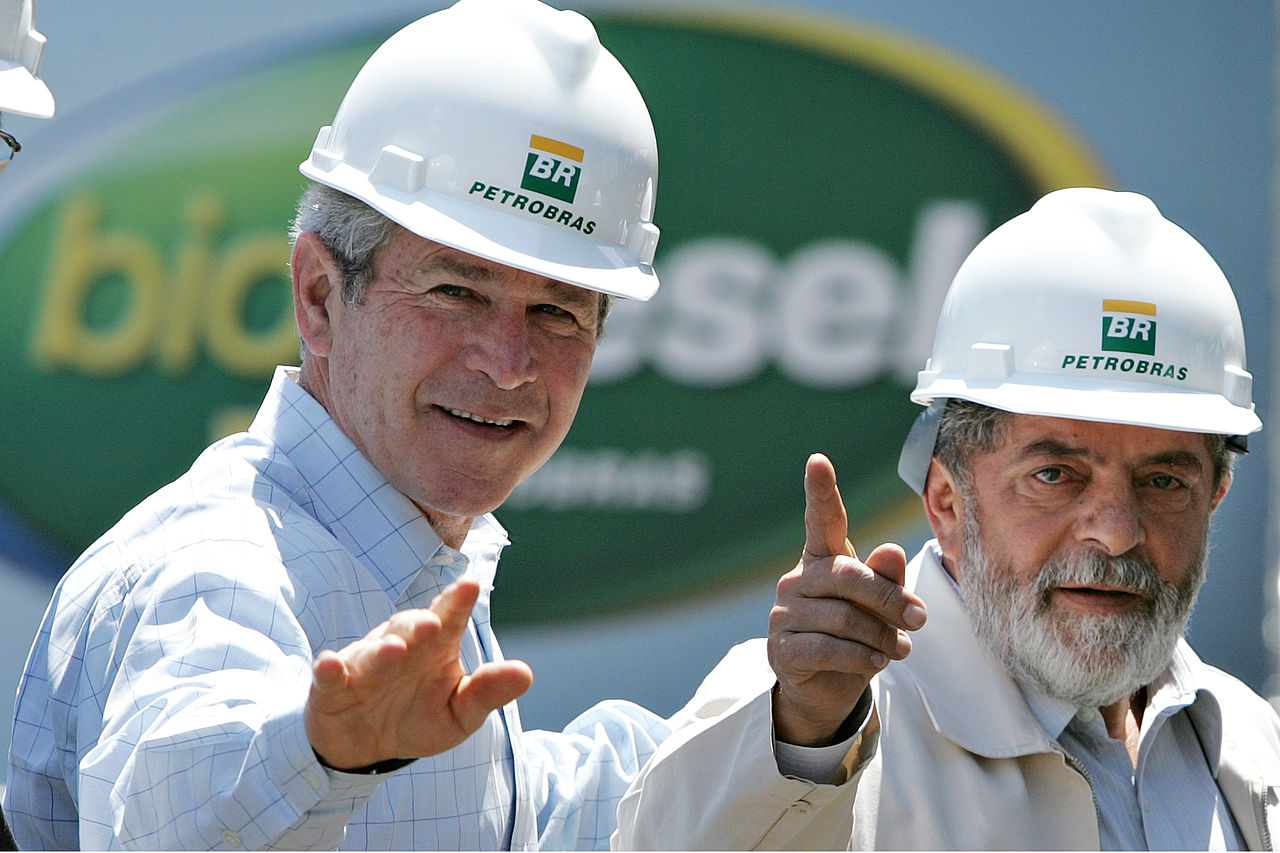
Electric
cars like the BMW
i3, and many other brands, could be converted to run on hydrogen fuel
cells. But, why were they not designed like that in the first place? When he
was president, George Bush, pushed for hydrogen to be developed for
transport. But did not push hard enough to actually make it happen.
Ethanol (EtOH; also called ethyl alcohol, grain alcohol, drinking alcohol, or simply alcohol) is an organic compound. It is a simple alcohol with the chemical formula C2H6O. Its formula can be also written as CH3−CH2−OH or C2H5OH (an ethyl group linked to a hydroxyl group). Ethanol is a volatile, flammable, colorless liquid with a characteristic wine-like odor and pungent taste. It is a psychoactive, recreational drug, and the active ingredient in alcoholic drinks.
Ethanol is naturally produced by the fermentation of sugars by yeasts or via petrochemical processes such as ethylene hydration. It has medical applications as an antiseptic and disinfectant. It is used as a chemical solvent and in the synthesis of organic compounds, and as a fuel source. Ethanol also can be dehydrated to make ethylene, an important chemical feedstock. Using
land to grow fuels for ICE
vehicles, instead of food
is ridiculous, where electricity can be
generated for EVs from wind turbines out at sea and on hills were crops
cannot be farmed. Electricity
can be stored as hydrogen and compounds thereof to resolve infrastructure
issues. But this technology has been stifled, with fossil fuel subsidies. So
here we are in 2022, heading into 2023, with food
and energy prices at crisis levels. There can be no doubt about that, as you
struggle to pay bills and feed the family.
PRODUCTION
Ethanol is produced both as a petrochemical, through the hydration of ethylene and, via biological processes, by fermenting sugars with yeast. Which process is more economical depends on prevailing prices of petroleum and grain feed stocks. In the 1970s most industrial ethanol in the United States was made as a petrochemical, but in the 1980s the United States introduced subsidies for corn-based ethanol and today it is almost all made from that source. In India ethanol is made from sugarcane.
ENGINE FUEL
The largest single use of ethanol is as an engine fuel and fuel additive. Brazil in particular relies heavily upon the use of ethanol as an engine fuel, due in part to its role as one of the globe's leading producers of ethanol. Gasoline sold in Brazil contains at least 25% anhydrous ethanol. Hydrous ethanol (about 95% ethanol and 5% water) can be used as fuel in more than 90% of new gasoline fueled cars sold in the country. Brazilian ethanol is produced from sugar cane, which has relatively high yields (830% more fuel than the fossil fuels used to produce it) compared to some other energy crops. The US and many other countries primarily use E10 (10% ethanol, sometimes known as gasohol) and E85 (85% ethanol) ethanol/gasoline mixtures.
Australian law limits the use of pure ethanol from sugarcane waste to 10% in automobiles. Older cars (and vintage cars designed to use a slower burning fuel) should have the engine valves upgraded or replaced.
According to an industry advocacy group, ethanol as a fuel reduces harmful tailpipe emissions of carbon monoxide, particulate matter, oxides of nitrogen, and other ozone-forming pollutants. Argonne National Laboratory analyzed greenhouse gas emissions of many different engine and fuel combinations, and found that biodiesel/petrodiesel blend (B20) showed a reduction of 8%, conventional E85 ethanol blend a reduction of 17% and cellulosic ethanol 64%, compared with pure gasoline. Ethanol has a much greater research octane number (RON) than gasoline, meaning it is less prone to pre-ignition, allowing for better ignition advance which means more torque, and efficiency in addition to the lower carbon emissions.
Ethanol combustion in an internal combustion engine yields many of the products of incomplete combustion produced by gasoline and significantly larger amounts of formaldehyde and related species such as
acetaldehyde. This leads to a significantly larger photochemical reactivity and more ground level ozone. This data has been assembled into The Clean Fuels Report comparison of fuel emissions and show that ethanol exhaust generates 2.14 times as much ozone as gasoline exhaust. When this is added into the custom Localized Pollution Index (LPI) of The Clean Fuels Report, the local pollution of ethanol (pollution that contributes to smog) is rated 1.7, where gasoline is 1.0 and higher numbers signify greater pollution. The California Air Resources Board formalized this issue in 2008 by recognizing control standards for formaldehydes as an emissions control group, much like the conventional
NOx and Reactive Organic Gases (ROGs).
World production of ethanol in 2006 was 51 gigalitres (1.3×1010 US gal), with 69% of the world supply coming from Brazil and the United States. More than 20% of Brazilian cars are able to use 100% ethanol as fuel, which includes ethanol-only engines and flex-fuel engines. Flex-fuel engines in Brazil are able to work with all ethanol, all gasoline or any mixture of both. In the US flex-fuel vehicles can run on 0% to 85% ethanol (15% gasoline) since higher ethanol blends are not yet allowed or efficient. Brazil supports this fleet of ethanol-burning automobiles with large national infrastructure that produces ethanol from domestically grown sugar cane. Sugar cane not only has a greater concentration of sucrose than corn (by about 30%), but is also much easier to extract. The bagasse generated by the process is not wasted, but is used in power plants to produce electricity.
In the United States, the ethanol fuel industry is based largely on corn (also known as maize). According to the Renewable Fuels Association, as of 30 October 2007, 131 grain ethanol bio-refineries in the United States have the capacity to produce 7.0 billion US gallons (26,000,000 m3) of ethanol per year. An additional 72 construction projects underway (in the US) can add 6.4 billion US gallons (24,000,000 m3) of new capacity in the next 18 months. Over time, it is believed that a material portion of the ≈150-billion-US-gallon (570,000,000 m3) per year market for gasoline will begin to be replaced with fuel ethanol.
Sweet sorghum is another potential source of ethanol, and is suitable for growing in dryland conditions. The International Crops Research Institute for the Semi-Arid Tropics (ICRISAT) is investigating the possibility of growing sorghum as a source of fuel, food, and animal feed in arid parts of Asia and Africa. Sweet sorghum has one-third the
water requirement of sugarcane over the same time period. It also requires about 22% less water than corn. The world's first sweet sorghum ethanol distillery began commercial production in 2007 in Andhra Pradesh, India.
Ethanol's high miscibility with water makes it unsuitable for shipping through modern pipelines like liquid hydrocarbons. Mechanics have seen increased cases of damage to small engines (in particular, the carburetor) and attribute the damage to the increased water retention by ethanol in fuel.
FUEL CELLS
Commercial fuel cells operate on reformed natural gas, hydrogen or methanol. Ethanol is an attractive alternative due to its wide availability, low cost, high purity and low toxicity. There is a wide range of fuel cell concepts that have entered trials including direct-ethanol fuel cells, auto-thermal reforming systems and thermally integrated systems. The majority of work is being conducted at a research level although there are a number of organizations at the beginning of the commercialization of ethanol fuel cells.
ROCKET FUEL
Ethanol was commonly used as fuel in early bipropellant rocket (liquid-propelled) vehicles, in conjunction with an oxidizer such as liquid oxygen. The German A-4 ballistic rocket of
World War
II, better known by its propaganda name V-2, which is credited as having begun the space age, used ethanol as the main constituent of B-Stoff. Under such nomenclature, the ethanol was mixed with 25% water to reduce the combustion chamber temperature. The V-2's design team helped develop US rockets following
World War II, including the ethanol-fueled Redstone rocket which launched the first US satellite. Alcohols fell into general disuse as more energy-dense rocket fuels were developed, although ethanol is currently used in lightweight rocket-powered racing aircraft. 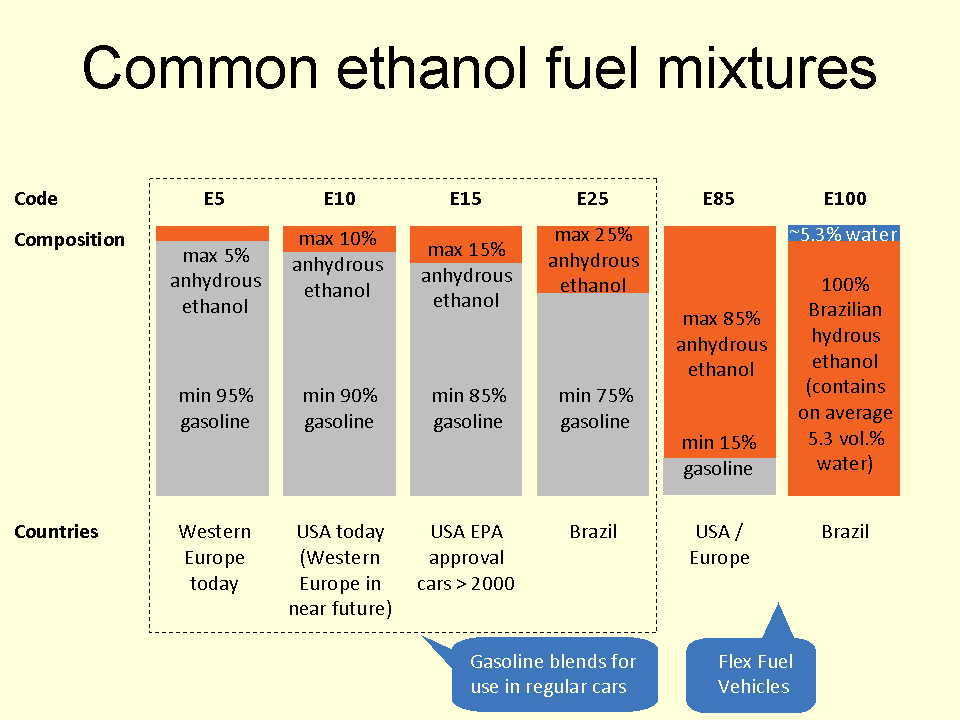
COMMON ETHANOL FUEL MIXTURES
Several common ethanol fuel mixtures are in use around the world.
Ethanol fuel mixtures have "E" numbers which describe the percentage of ethanol fuel in the mixture by volume, for example, E85 is 85% anhydrous ethanol and 15% gasoline. Low-ethanol blends are typically from E5 to E25, although internationally the most common use of the term refers to the E10 blend.
Blends of E10 or less are used in more than 20 countries around the world, led by the United States, where ethanol represented 10% of the U.S. gasoline fuel supply in 2011. Blends from E20 to E25 have been used in Brazil since the late 1970s. E85 is commonly used in the U.S. and Europe for flexible-fuel vehicles. Hydrous ethanol or E100 is used in Brazilian neat ethanol vehicles and flex-fuel light vehicles and hydrous E15 called hE15 for modern petrol cars in the Netherlands.
E10
E10, a fuel mixture of 10% anhydrous ethanol and 90% gasoline sometimes called gasohol, can be used in the internal combustion engines of most modern automobiles and light-duty vehicles without need for any modification on the engine or fuel system. E10 blends are typically rated as being 2 to 3 octane numbers higher than regular gasoline and are approved for use in all new U.S. automobiles, and mandated in some areas for emissions and other reasons. The E10 blend and lower ethanol content mixtures have been used in several countries, and its use has been primarily driven by the several world energy shortages that have taken place since the 1973 oil crisis. 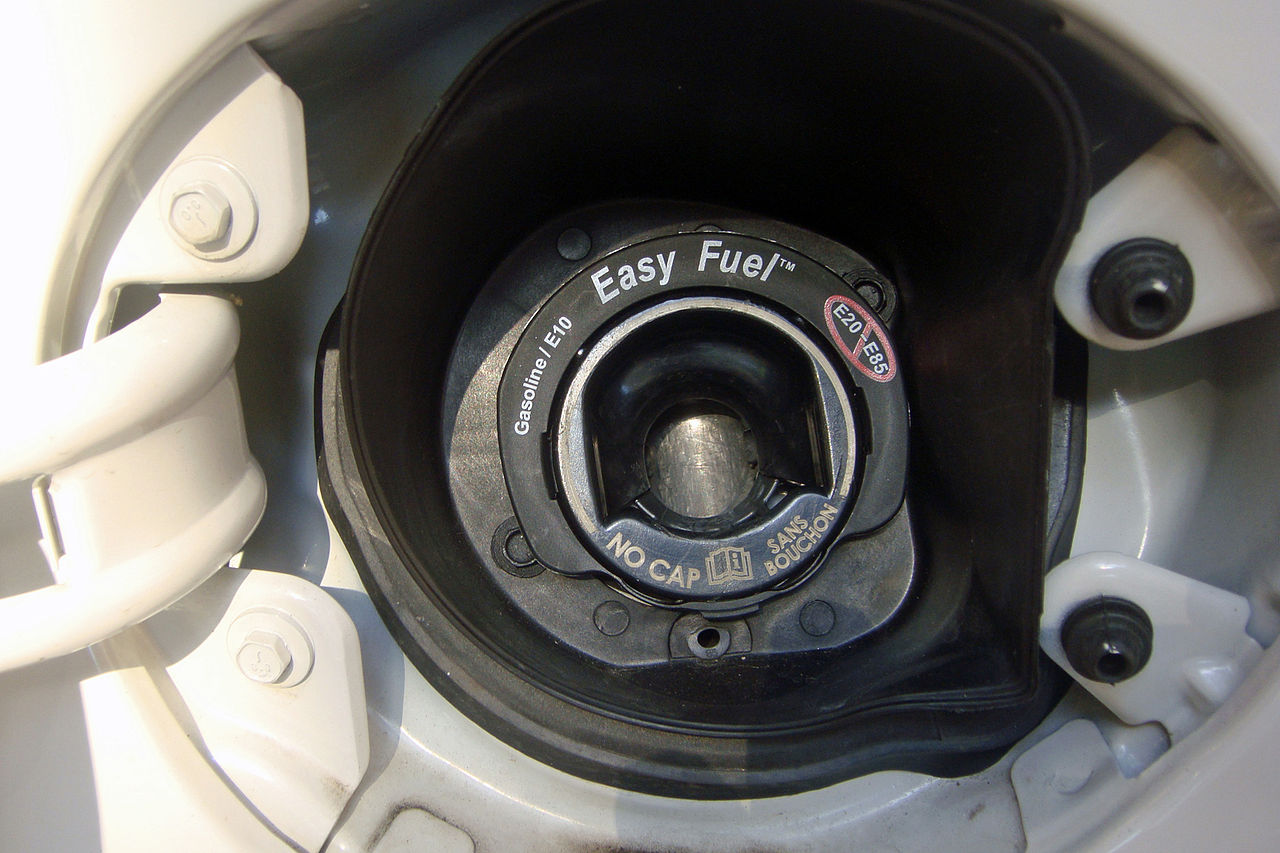
E15
E15 contains 15% ethanol and 85% gasoline. This is generally the highest ratio of ethanol to gasoline that is possible to use in vehicles recommended by some auto manufacturers to run on E10 in the US. This is due to ethanol's hydrophilia and solvent power.
As a result of the Energy Independence and Security Act of 2007, which mandates an increase in renewable fuels for the transport sector, the U.S. Department of Energy began assessments for the feasibility of using intermediate ethanol blends in the existing vehicle fleet as a way to allow higher consumption of ethanol fuel. The National Renewable Energy Laboratory (NREL) conducted tests to evaluate the potential impacts of intermediate ethanol blends on legacy vehicles and other engines. In a preliminary report released in October 2008, the NREL presented the results of the first evaluations of the effects of E10, E15 and E20 gasoline blends on tailpipe and evaporative emissions, catalyst and engine durability, vehicle driveability, engine operability, and vehicle and engine materials. This preliminary report found none of the vehicles displayed a malfunction indicator light as a result of the ethanol blend used; no fuel filter plugging symptoms were observed; no cold start problems were observed at 24 °C (75 °F) and 10 °C (50 °F) laboratory conditions; and as expected, computer technology available in newer model vehicles adapts to the higher octane causing lower emissions with greater horsepower and in some cases greater fuel economy.
In March 2009, a lobbying group from the ethanol industry, Growth Energy, formally requested the U.S. Environmental Protection Agency (EPA) to allow the ethanol content in gasoline to be increased to 15% from 10%. Organizations doing such studies included the Energy Department, the State of Minnesota, the Renewable Fuels Association, the Rochester Institute of Technology, the Minnesota Center for Automotive Research, and Stockholm University in Sweden.
In October 2010, the EPA granted a waiver to allow up to 15% of ethanol blended with gasoline to be sold only for cars and light pickup trucks with a model year of 2007 or later, representing about 15% of vehicles on U.S. roads. In January 2011, the waiver was expanded to authorize use of E15 to include model year 2001 through 2006 passenger vehicles. The EPA also decided not to grant any waiver for E15 use in any motorcycles, heavy-duty vehicles, or
non-road engines because current testing data do not support such a waiver. According to the Renewable Fuels Association, the E15 waivers now cover 62% of vehicles on the road in the US, and the ethanol group estimates if all 2001 and newer cars and pickups were to use E15, the theoretical blend wall for ethanol use would be approximately 17.5 billion gallons (66.2 billion liters) per year. The EPA was still studying if older cars can withstand a 15% ethanol blend.
The EPA waiver authorizes sale of E15 only from Sep 15 to May 31 out of a black hose and a yellow hose to flex fuel vehicles only from June 1 to Sep 14. Retailers have shunned building infrastructure due to the costly regulatory requirements which have created a practical barrier to the commercialization of the higher blend. Most fuel stations do not have enough pumps to offer the new blend, few existing pumps are certified to dispense E15, and no dedicated tanks are readily available to store E15. Also, some state and federal regulations would have to change before E15 can be legally sold. The National Association of Convenience Stores, which represents most gasoline retailers, considers the potential for actual E15 demand is small, "because the auto industry is not embracing the fuel and is not adjusting their warranties or recommendations for the fuel type." One possible solution to the infrastructure barriers is the introduction of blender pumps that allow consumers to turn a dial to select the level of ethanol, which would also allow owners of flexible-fuel cars to buy E85 fuel.
In June 2011 EPA, in cooperation with the Federal Trade Commission, issued its final ruling regarding the E15 warning label required to be displayed in all E15 fuel dispensers in the U.S. to inform consumers about what vehicles can, and what vehicles and equipment cannot, use the E15 blend. Both the Alliance of Automobile Manufacturers and the National Petrochemical and Refiners Association complained that relying solely on this warning label is not enough to protect consumers from misfueling. In July 2012, a fueling station in Lawrence, Kansas became the first in the U.S. to sell the E15 blend. The fuel is sold through a blender pump that allows customers to choose between E10, E15, E30 or E85, with the latter blends sold only to flexible-fuel vehicles. As of June 2013, there are about 24 fueling stations selling E15 out of 180,000 stations across the U.S.
In December 2010, several groups, including the Alliance of Automobile Manufacturers, the American Petroleum Institute, the Association of International Automobile Manufacturers, the National Marine Manufacturers Association, the Outdoor Power Equipment Institute, and the Grocery Manufacturers Association, filed suit against the EPA in the United States Court of Appeals for the District of Columbia Circuit. The plaintiffs argued the EPA does not have the authority to issue a “partial waiver” that covers some cars and not others. Among other arguments, the groups argued that the higher ethanol blend is not only a problem for cars, but also for fuel pumps and underground tanks not designed for the E15 mixture. It was also argued that the rise in ethanol has contributed to the big jump in corn prices in recent years. In August 2012, the federal appeals court rejected the suit against the EPA. The case was thrown out on a technical reason, as the court ruled the groups did not have legal standing to challenge EPA's decision to issue the waiver for E15. In June 2013 the U.S. Supreme Court declined to hear an appeal from industry groups opposed to the EPA ruling about E15, and let the 2012 federal appeals court ruling stand.
As of November 2012, sales of E15 are not authorized in California, and according to the California Air Resources Board (CARB), the blend is still awaiting approval, and in a public statement the agency said that "it would take several years to complete the vehicle testing and rule development necessary to introduce a new transportation fuel into California's market."
According to a survey conducted by the American Automobile Association (AAA) in 2012, only about 12 million out of the more than 240 million light-duty vehicles on the U.S. roads in 2012 are approved by manufacturers are fully compliant with E15 gasoline. According with the Association, BMW, Chrysler, Nissan, Toyota, and Volkswagen warned that their warranties will not cover E15-related damage. Despite the controversy, in order to adjust to EPA regulations, 2012 and 2013 model year vehicles manufactured by General Motors can use fuel containing up to 15 percent ethanol, as indicated in the vehicle owners' manuals. However, the carmaker warned that for model year 2011 or earlier vehicles, they "strongly recommend that GM customers refer to their owners manuals for the proper fuel designation for their vehicles." Ford Motor Company also is manufacturing all of its 2013 vehicles E15 compatible, including hybrid electrics and vehicles with Ecoboost engines. Also Porsches built since 2001 are approved by its manufacturer to use E15. Volkswagen announced that for the 2014 model year, its entire lineup will be E15 capable. Fiat Chrysler Automobiles announced in August 2015 that all 2016 model year Chrysler/Fiat, Jeep, Dodge and Ram vehicles will be E15 compatible.
In November 2013, the Environmental Protection Agency opened for public comment its proposal to reduce the amount of ethanol required in the U.S. gasoline supply as mandated by the Energy Independence and Security Act of 2007. The agency cited problems with increasing the blend of ethanol above 10%. This limit, known as the "blend wall," refers to the practical difficulty in incorporating increasing amounts of ethanol into the transportation fuel supply at volumes exceeding those achieved by the sale of nearly all gasoline as E10. 
E20 - E25
E20 contains 20% ethanol and 80% gasoline, while E25 contains 25% ethanol. These blends have been widely used in Brazil since the late 1970s. As a response to the 1973 oil crisis, the Brazilian government made mandatory the blend of ethanol fuel with gasoline, fluctuating between 10% to 22% from 1976 until 1992. Due to this mandatory minimum gasoline blend, pure gasoline (E0) is no longer sold in Brazil. A federal law was passed in October 1993 establishing a mandatory blend of 22% anhydrous ethanol (E22) in the entire country. This law also authorized the Executive to set different percentages of ethanol within pre-established boundaries, and since 2003, these limits were fixed at a maximum of 25% (E25) and a minimum of 20% (E20) by volume. Since then, the government has set the percentage on the ethanol blend according to the results of the sugarcane harvest and ethanol production from sugarcane, resulting in blend variations even within the same year.
Since July 1, 2007, the mandatory blend was set at 25% of anhydrous ethanol (E25) by executive decree, and this has been the standard gasoline blend sold throughout Brazil most of the time as of 2011. However, as a result of a supply shortage and the resulting high ethanol fuel prices, in 2010, the government mandated a temporary 90-day blend reduction from E25 to E20 beginning February 1, 2010. As prices rose abruptly again due to supply shortages that took place again between the 2010 and 2011 harvest seasons, some ethanol had to be imported from the United States, and in April 2011, the government reduced the minimum mandatory blend to 18%, leaving the mandatory blend range between E18 and E25.
All Brazilian automakers have adapted their gasoline engines to run smoothly with this range of mixtures, thus, all gasoline vehicles are built to run with blends from E20 to E25, defined by local law as "common gasoline type C". Some vehicles might work properly with lower concentrations of ethanol, but with a few exceptions, they are unable to run smoothly with pure gasoline, which causes engine knocking, as vehicles traveling to neighboring South American countries have demonstrated. Flex-fuel vehicles, which can run on any type of gasoline E20-E25 up to 100% hydrous ethanol (E100 or hydrated ethanol) ratios, were first available in mid-2003. In July 2008, 86% of all new light vehicles sold in Brazil were flexible-fuel, and only two carmakers build models with a flex-fuel engine optimized to operate with pure gasoline (E0): Renault with the models Clio, Symbol, Logan, Sandero and Mégane, and Fiat with the Siena Tetrafuel.
Thailand introduced E20 in 2008, but shortages in ethanol supplies by mid-2008 caused a delay in the expansion of the E20 fueling station network in the country. By mid-2010, 161 fueling stations were selling E20, and sales have risen 80% since April 2009. The rapid growth in E20 demand is because most vehicle models launched since 2009 were E20-compatible, and sales of E20 are expected to grow faster once more local automakers start producing small, E20-compatible, fuel-efficient cars. The Thai government is promoting ethanol usage through subsidies, as ethanol costs four baht (about 12 US cents) a litre more than gasoline.
A state law approved in Minnesota in 2005 mandated that ethanol comprise 20% of all gasoline sold in this American state beginning in 2013. Successful tests have been conducted to determine the performance under E20 by current vehicles and fuel dispensing equipment designed for E10. However, this mandate was later delayed to 2015, and has never taken effect because the federal EPA has yet to authorize the use of E20 as a replacement for gasoline.
A study commissioned by BP and published in September 2013, concluded that the use of advanced biofuels in the UK, and particularly E20 cellulosic ethanol, is a more cost-effective way of reducing emissions than using plug-in electric vehicles (PEVs) in the timeframe to 2030. The study also found that the use of higher blends of biofuels is complementary to hybrid electric vehicles (HEVs) and plug-in hybrids (PHEVs). Battery electric vehicles (BEVs) can deliver strong CO2 savings with a decarbonised electric grid, but are expected to have significantly higher costs than internal combustion engine vehicles and hybrid cars to 2030, as the latter are expected to be the most popular models by 2030. According to the study, in 2030 an E20 blend in an HEV can achieve a 10% emission savings compared to an HEV running on E5, for an annual fuel cost premium of £13 compared to an annual cost of £195 for an all-electric car.
ED95
ED95 designates a blend of 95% ethanol and 5% ignition improver; it is used in modified diesel engines where high compression is used to ignite the fuel, as opposed to the operation of gasoline engines, where spark plugs are used. This fuel was developed by Swedish ethanol producer SEKAB. Because of the high ignition temperatures of pure ethanol, the addition of ignition improver is necessary for successful diesel engine operation. A diesel engine running on ethanol also has a higher compression ratio and an adapted fuel system.
This fuel has been used with success in many Swedish Scania buses since 1985, which has produced around 700 ethanol buses, more than 600 of them to Swedish cities, and more recently has also delivered ethanol buses for commercial service in Great Britain, Spain, Italy, Belgium, and Norway. As of June 2010 Stockholm has the largest ethanol ED95 bus fleet in the world.
As of 2010, the Swedish ED95 engine is in its third generation and already has complied with Euro 5 emission standards, without any kind of post-treatment of the exhaust gases. The ethanol-powered engine is also being certified as environmentally enhanced vehicle (EEV) in the Stockholm municipality. The EEV rule still has no date to enter into force in Europe and is stricter than the Euro 5 standard.
Nottingham became the first city in England to operate a regular bus service with ethanol-fuelled vehicles. Three ED95 single-deck buses entered regular service in the city in March 2008. Soon after, Reading also introduced ED95 double-deck buses.
Under the auspices of the BioEthanol for Sustainable Transport project, more than 138 bioethanol ED95 buses were part of demonstration trial at four cities, three in Europe, and one in Brazil, between 2006 and 2009. A total of 127 ED95 buses operated in Stockholm, five buses operated in Madrid, three in La Spezia, and one in Brazil. In Brazil, the first Scania ED95 bus with a modified diesel engine was introduced as a trial in São Paulo city in December 2007, and since November 2009, two ED95 buses were in regular service. The Brazilian trial project ran for three years and performance and emissions were monitored by the National Reference Center on Biomass (CENBIO- Portuguese: Centro Nacional de Referência em Biomassa) at the Universidade de São Paulo.
In November 2010, the municipal government of São Paulo city signed an agreement with UNICA, Cosan, Scania and Viação Metropolitana, a local bus operator, to introduced a fleet of 50 ethanol-powered ED95 buses by May 2011. Scania manufactures the bus engine and chassis in its plant located in São Bernardo do Campo, São Paulo, using the same technology and fuel as the ED95 buses already operating in Stockholm. The bus body is a Brazilian CAIO. The first ethanol-powered buses were delivered in May 2011, and the 50 buses will start regular service in June 2011 in the southern region of São Paulo. The 50 ED95 buses had a cost of R$ 20 million (US$12.3 million) and due to the higher cost of the ED95 fuel and the lower energy content of ethanol as compared to diesel, one of the firms participating in the cooperation agreement, Raísen (a joint venture between Royal Dutch Shell and Cosan), supplies the fuel to the municipality at 70% of the market price of regular diesel.
E100
E100 is pure ethanol fuel. Straight hydrous ethanol as an automotive fuel has been widely used in Brazil since the late 1970s for neat ethanol vehicles and more recently for flexible-fuel vehicles. The ethanol fuel used in Brazil is distilled close to the azeotrope mixture of 95.63% ethanol and 4.37% water (by weight) which is approximately 3.5% water by volume. The azeotrope is the highest concentration of ethanol that can be achieved by simple fractional distillation. The maximum water concentration according to the ANP specification is 4.9 vol.% (approximately 6.1 weight%) The E nomenclature is not adopted in Brazil, but hydrated ethanol can be tagged as E100, meaning it does not have any gasoline, because the water content is not an additive, but rather a residue from the distillation process. However, straight hydrous ethanol is also called E95 by some authors.
The first commercial vehicle capable of running on pure ethanol was the Ford Model T, produced from 1908 through 1927. It was fitted with a carburetor with adjustable jetting, allowing use of gasoline or ethanol, or a combination of both. At that time, other car manufacturers also provided engines for ethanol fuel use. Thereafter, and as a response to the 1973 and 1979 energy crises, the first modern vehicle capable of running with pure hydrous ethanol (E100) was launched in the Brazilian market, the Fiat 147, after testing with several prototypes developed by the Brazilian subsidiaries of Fiat, Volkswagen, General Motors and Ford. As of September 2012, there were 1.1 million neat ethanol vehicles still in use in Brazil. Since 2003, Brazilian newer flex-fuel vehicles are capable of running on pure hydrous ethanol (E100) or blended with any combination of E20 to E27.5 gasoline (a mixture made with anhydrous ethanol), the national mandatory blend. As of September 2012, there were 17.1 million flexible-fuel vehicles running on Brazilian roads.
E100 imposes a limitation on normal vehicle operation, as ethanol's lower evaporative pressure (as compared to gasoline) causes problems when cold starting the engine at temperatures below 15 °C (59 °F). For this reason, both pure ethanol and E100 flex-fuel vehicles are built with an additional small gasoline reservoir inside the engine compartment to help in starting the engine when cold by initially injecting gasoline. Once started, the engine is then switched back to ethanol. An improved flex-fuel engine generation was developed to eliminate the need for the secondary gas tank by warming the ethanol fuel during starting, and allowing them to start at temperatures as low as −5 °C (23 °F), the lowest temperature expected anywhere in the Brazilian territory. The Polo E-Flex, launched in March 2009, was the first flex-fuel model without an auxiliary tank for cold start. The warming system, called Flex Start, was developed by Robert Bosch GmbH.
Swedish carmakers have developed ethanol-only capable engines for the new Saab Aero X BioPower 100 Concept E100, with a V6 engine which is fuelled entirely by E100 bioethanol, and the limited edition of the Koenigsegg CCXR, a version of the CCX converted to use E85 or E100, as well as standard 98-octane gasoline, and currently the fastest and most powerful flex-fuel vehicle with its twin-supercharged V8 producing 1018 hp when running on biofuel, as compared to 806 hp on 91-octane unleaded gasoline.
The higher fuel efficiency of E100 (compared to methanol) in high performance race cars resulted in Indianapolis 500 races in 2007 and 2008 being run on 100% fuel-grade ethanol.
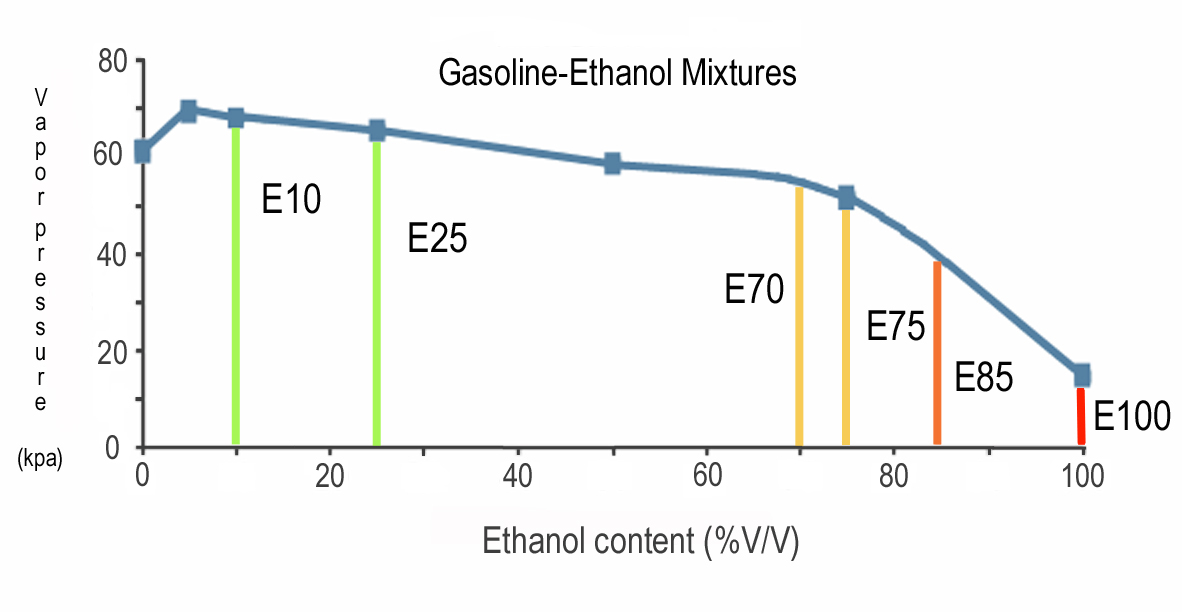
FOSSIL
FUELS Europe and the USA is addicted to harmful
fuels like coal,
gas and
oil for
power generation, and diesel
and petroleum
for transport. Despite the lung
cancer it is causing to thousands of victims in cities every year.
Ethanol of mixed with petroleum/gasoline, despite the land used to grow
grain crops, that could have been used to feed the world, or reduced the
destruction of rain forests. It
is a UN
SDG
requirement for governments to provide cheap
energy and sustainable
transportation. But each year we have a FLOP,
instead of a COP. GLOBAL FOOD PRICES
CRISIS
While Bush was in São Paulo as part of the 2007 Latin American tour, Venezuela's President Hugo Chavez, from Buenos Aires, dismissed the ethanol plan as "a crazy thing" and accused the U.S. of trying "to substitute the production of foodstuffs for animals and human beings with the production of foodstuffs for vehicles, to sustain the American way of life." Chavez' complaints were quickly followed by then Cuban President Fidel Castro, who wrote that "you will see how many people among the hungry masses of our planet will no longer consume corn." "Or even worse", he continued, "by offering financing to poor countries to produce ethanol from corn or any other kind of food, no tree will be left to defend humanity from climate change." Daniel Ortega, Nicaragua's President, and one of the preferential recipients of Brazil technical aid, said that "we reject the gibberish of those who applaud Bush's totally absurd proposal, which attacks the
food security rights of Latin Americans and Africans, who are major corn consumers", however, he voiced support for sugar cane based ethanol during Lula's visit to Nicaragua.
As a result of the international community's concerns regarding the steep increase in food prices, on 14 April 2008, Jean Ziegler, the United Nations Special Rapporteur on the Right to Food, at the Thirtieth Regional Conference of the
Food and Agriculture Organization (FAO) in Brasília, called biofuels a "crime against humanity", a claim he had previously made in October 2007, when he called for a 5-year ban for the conversion of land for the production of biofuels. The previous day, at their Annual International Monetary Fund and World Bank Group meeting at Washington, D.C., the World Bank's President, Robert Zoellick, stated that "While many worry about filling their gas tanks, many others around the world are struggling to fill their stomachs. And it's getting more and more difficult every day."
Luiz Inácio Lula da Silva gave a strong rebuttal, calling both claims "fallacies resulting from commercial interests", and putting the blame instead on U.S. and European agricultural subsidies, and a problem restricted to U.S. ethanol produced from
maize. He also said that "biofuels aren't the villain that threatens food
security". In the middle of this new wave of criticism, Hugo Chavez reaffirmed his opposition and said that he is concerned that "so much U.S.-produced corn could be used to make biofuel, instead of feeding the world's poor", calling the U.S. initiative to boost ethanol production during a world food crisis a "crime".
German Chancellor Angela Merkel said the rise in food prices is due to poor agricultural policies and changing eating habits in developing nations, not biofuels as some critics claim. On the other hand, British Prime Minister Gordon Brown called for international action and said Britain had to be "selective" in supporting biofuels, and depending on the UK's assessment of biofuels' impact on world food prices, "we will also push for change in EU biofuels targets". Stavros Dimas, European Commissioner for the Environment said through a spokeswoman that "there is no question for now of suspending the target fixed for biofuels", though he acknowledged that the EU had underestimated problems caused by biofuels.
On 29 April 2008, U.S. President George W. Bush declared during a press conference that "85 percent of the world's food prices are caused by weather, increased demand and energy prices", and recognized that "15 percent has been caused by ethanol". He added that "the high price of
gasoline is going to spur more investment in ethanol as an alternative to gasoline. And the truth of the matter is it's in our national interests that our farmers grow energy, as opposed to us purchasing energy from parts of the world that are unstable or may not like us." Regarding the effect of agricultural subsidies on rising food prices, Bush said that "Congress is considering a massive, bloated farm bill that would do little to solve the problem. The bill Congress is now considering would fail to eliminate subsidy payments to multi-millionaire farmers", he continued, "this is the right time to reform our nation's farm policies by reducing unnecessary subsidies".
Just a week before this new wave of international controversy began, U.N. Secretary General Ban Ki-moon had commented that several U.N. agencies were conducting a comprehensive review of the policy on biofuels, as the world food price crisis might trigger global instability. He said "We need to be concerned about the possibility of taking land or replacing arable land because of these biofuels", then he added "While I am very much conscious and aware of these problems, at the same time you need to constantly look at having creative sources of energy, including biofuels. Therefore, at this time, just criticising biofuel may not be a good solution. I would urge we need to address these issues in a comprehensive manner." Regarding Jean Ziegler's proposal for a five-year ban, the U.N. Secretary rejected that proposal.
A report released by Oxfam in June 2008 criticized biofuel policies of high-income countries as neither a solution to the climate crisis nor the oil crisis, while contributing to the food price crisis. The report concluded that from all biofuels available in the market, Brazilian sugarcane ethanol is not very effective, but it is the most favorable biofuel in the world in term of cost and greenhouse gas balance. The report discusses some existing problems and potential risks, and asks the Brazilian government for caution to avoid jeopardizing its environmental and social sustainability. The report also says that: "Rich countries spent up to $15 billion last year supporting biofuels while blocking cheaper Brazilian ethanol, which is far less damaging for global food security."
A World Bank research report published in July 2008 found that from June 2002 to June 2008 "biofuels and the related consequences of low grain stocks, large land use shifts, speculative activity and export bans" pushed prices up by 70 percent to 75 percent. The study found that higher oil prices and a weak dollar explain 25–30% of total price rise. The study said that "large increases in biofuels production in the United States and Europe are the main reason behind the steep rise in global food prices" and also stated that "Brazil's sugar-based ethanol did not push food prices appreciably higher". The Renewable Fuels Association (RFA) published a rebuttal based on the version leaked before its formal release. The RFA critique considers that the analysis is highly subjective and that the author "estimates the impact of global food prices from the weak dollar and the direct and indirect effect of high petroleum prices and attributes everything else to biofuels".
An economic assessment by the OECD also published in July 2008 agrees with the
World Bank report regarding the negative effects of subsidies and trade restrictions, but found that the impact of biofuels on food prices are much smaller. The OECD study is also critical of the limited reduction of greenhouse gas emissions achieved from biofuels produced in Europe and North America, concluding that the current biofuel support policies would reduce greenhouse gas emissions from transport fuel by no more than 0.8 percent by 2015, while Brazilian ethanol from sugar cane reduces
greenhouse gas emissions by at least 80 percent compared to fossil fuels. The assessment calls on governments for more open markets in biofuels and feedstocks in order to improve efficiency and lower costs. The OECD study concluded that "current biofuel support measures alone are estimated to increase average wheat prices by about 5 percent, maize by around 7 percent and vegetable oil by about 19 percent over the next 10 years."
Another World Bank research report published in July 2010 found their previous study may have overestimated the contribution of biofuel production, as the paper concluded that "the effect of biofuels on food prices has not been as large as originally thought, but that the use of commodities by financial investors (the so-called "financialization of commodities") may have been partly responsible for the 2007/08 spike" 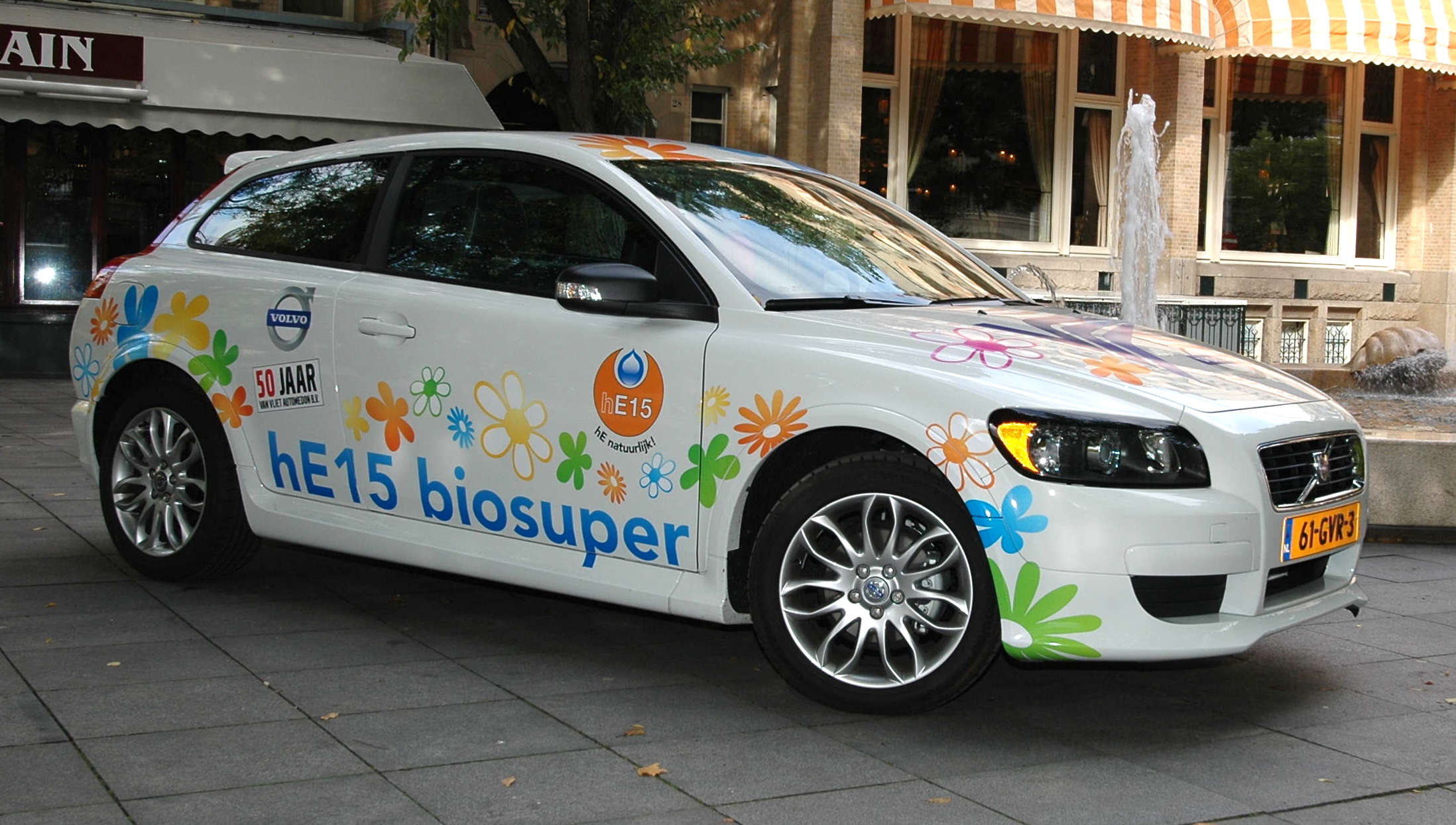
LINKS
& REFERENCE https://
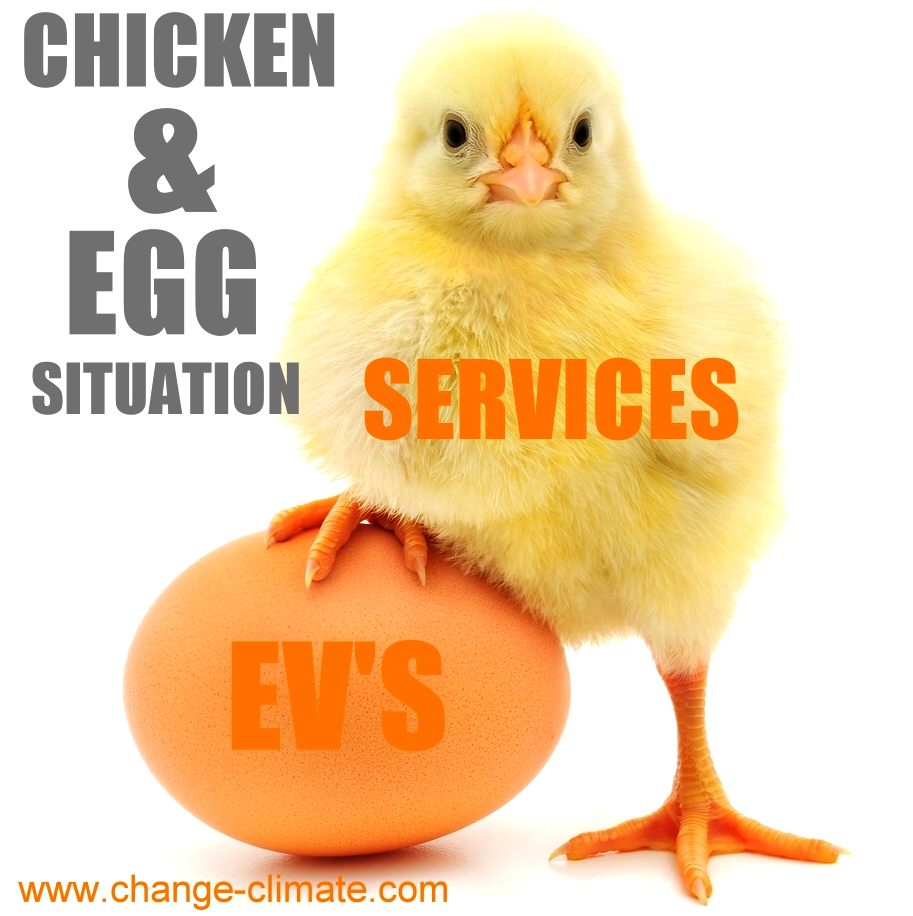
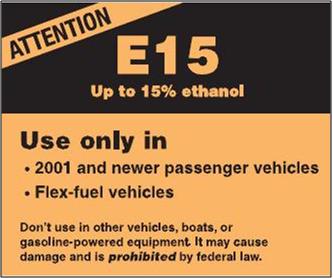
Please
use our A-Z
INDEX to navigate this site
This
website is provided on a free basis to
promote zero emission transport from renewable energy in Europe and Internationally. Copyright ©
Universal Smart Batteries and Climate Change Trust 2022. Solar
Studios, BN271RF, United Kingdom. The name SmartNet™ is a trademark.
|






